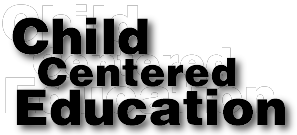For further information and clarification about mainstreaming, including the pros and cons of instituting this practice into our public school system, see the group on Disabilities.
Child-Centered Approaches to the Learning Disabled
Most of the learning disabilities which afflict nearly 10 million American children are reading impairments. The question that subsequently arises out of this fact is, "can certain reading impairments be avoided by applying different teaching styles?" A couple of decades ago, many teachers were advocating whole language instruction in the subject of reading. This approach, very child-centered in its orientation, theorized that children learn to read in the same manner as they learn to speak - naturally. Therefore, whole language instruction aimed to surround children with real literature, hoping that the skill of reading would soak in as naturally as learning to speak the English language. Unfortunately, many children who received this whole language instruction began to develop certain deficiencies in their reading skills, namely ignorance of phonics, or basic skills instruction.
This lack of basic skill instruction has, according to educational researcher E.D. Hirsch, contributed to the declining state of the American educational system and the subsequent inferiority of its students in comparison to their international peers. In his recent book, The Schools We Need, Hirsch writes that, "our K-12 education is among the least effective in the developed world...its controlling theories, curricular incoherencies, and what I call its Ònaturalistic fallaciesÓ are positive barriers to a good education." Hirsch does not dismiss the importance of ÔindividualizedÕ education, even asserting that "unquestionably, differences in temperament and ability make individualized, one-on-one tutorials the most effective mode of teaching known." However, he explains that a paradox exists wherein more 'individualized' attention for some inherently means 'individual neglect' for others. E.D Hirsch champions a more traditional lockstep system of schooling, with a higher priority on 'rigor' than flexibility.
Contemporary teaching wisdom now espouses a more middle of the road approach to reading known as "balanced" instruction, in which both phonics and whole language instruction are taught. However, what educators can learn from this example is that complete child-centered approaches do not necessarily lead to the best results every time. Although more individualized, and seemingly more conducive to student differences, child-centered approaches can sometimes ignore important subject-centered needs.
Specific Schools for Learning Disabled Students
The Maplebrook School:
One school in which IEP's are used solely in the teaching of "youngsters with learning differences and attention deficit disorder (ADD) is the Maplebrook School of Amenia, New York. The Maplebrook School strives to provide high quality education for children and adolescents who may be considered "slow," or who show clear learning differences when compared to the "norm." Along with the Individualized Learning Plans, Maplebrook has instituted tutorial programs (both individual and small-group), and also emphasizes small class sizes (typically 4-10 students per class). These attributes help set the private Maplebrook School apart from the way in which "slow" or disabled children typically receive an education at the public level. Public school educators are less hands-on and the class sizes are frequently much larger (typically 20-30 students), making individual attention less available. Child-centered education through greater individual attention is the key to the Maplebrook School.
Kids Are People School (Boston, MA):
"Because we feel that every child, at one time or another, could potentially be defined as a child with special needs, it is our belief that education should not be divided into normal vs. special needs programming, either in conducting programs or in staff training" (Blenk and Fine, 1995). This quote accurately sums up the purpose and direction of this "all inclusive" educational program located in the heart of Boston. The Kids Are People School epitomizes the concept of child-centered education by treating every child equally under the general, yet meaningful three-fold philosophy:
- that children are safe
- that children are happy
- that the children are growing, developing, and learning
The children who attend this school run the gamut of diversity in terms of "normal child development." Some children would likely be classified as normally developed, some have learning disabilities, and still others "can barely move a hand to communicate." As a result, individualized attention (including much more specialized attention than required at the milder-disability Maplebrook School) forms the cornerstone of this "inclusive" school.
Curative Schools:
Another set of schools which focus on the teaching of disabled students only, are known as Curative Schools. The principles of Curative Education are directly derived from the philosophy of Rudolf Steiner, and are directly related to his Waldorf style of teaching. The Curative approach to teaching attempts to recognize, and expose the positive attributes and capabilities of the disabled. "The focus is a mutual effort to reach an imaginative, even intuitive awareness of the significance of individuals who are handicapped and to affirm their task in life-and that of those around them" (House of Peace...Curative Counseling Page). Although the child-centered philosophy exhibited in the Waldorf Schools aims to incorporate all children together, regardless of ability, the Curative School is an approach specially designed for the teaching of children with learning disabilities.
Government 375: Educational Reform and Ideology

